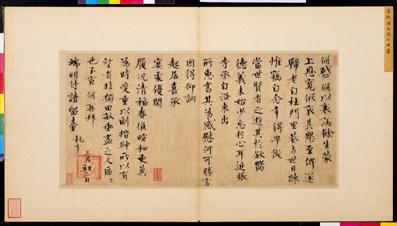宋人法書(一) 冊 宋歐陽脩致端明侍讀留臺執事尺牘
推薦分享
資源連結
連結到原始資料 (您即將開啟新視窗離開本站)後設資料
- 資料識別:
- 故書000243N000000007
- 資料類型:
- 類型:書法
- 型式:文字
- 著作者:
- 歐陽修
- 出版者:
- 數位化執行單位:國立故宮博物院
- 格式:
- 本幅 25.9x53.4公分
- 語言:
- 漢文
- 關聯:
- 石渠寶笈續編(乾清宮),第一冊,頁445 &*故宮書畫錄(卷三),第一冊,頁178-180 &*1.鄭瑤賜,〈歐陽脩致端明侍讀留臺執事尺牘〉,收入國立故宮博物院編,《宋代書畫冊頁名品特展》(臺北:國立故宮博物院,1995年初版一刷),頁234-236。 2.鄭瑤賜,〈「七十件書畫冊頁名品特展」精選(四) — 歐陽修致端明侍讀留臺執事尺牘〉,《故宮文物月刊》,第149期(1995年8月),頁90-93。 &*歐陽脩(西元1007-1072年),盧陵(今江西吉安)人。自永叔,字號醉翁,晚號六一居士,卒諡文忠。他學識淵博,敏悟過人,讀書過目成誦,其書法獨具風格,惟為博學所掩,世人罕知其亦書。 歐陽脩曾謂:「書之廢莫廢於今,書之盛莫盛於唐。」他是傳統書家,深受顏真卿與李邕影響,一向善寫楷書,早期與晚期變化不大。行草書流傳甚少,至於其書法特色,大弟子蘇軾評述最為中肯:「歐陽文忠公,用尖筆,乾墨,寫方闊字。」本幅選自「宋人法書冊一」第七幅。&*Ou-yang Hsiu was a native of Lu-ling (modern Chi-an , Kiangsi). His style name was Yung-shu, sobriquets were Tsui-weng and Liu-I chu-shih, and posthumous title was Wen-chung. His learning was vast and his intelligence unsurpassed, being able to retain everything he studied. The style of his calligraphy was also unique. However, due to his vast learning, few people have paid much attention to his achievements in calligraphy. Ou-yang Hsiu once wrote, "The decline of calligraphy has occurred in modern times, and the peak took place in the T'ang dynasty [618-907]. " Ou-yang was a very traditional calligrapher, being deeply influenced by the styles of Yen Chen-ch'ing (709-785) and Li Yung (678-747). He excelled at regular script throughout his career, and the differences between his early and late styles were not very great. Examples of his running grass script which survive today are scarce. In terms of the uniqueness of his calligraphy , his great disciple Su Tung-p'o (1036-1101) summed it up just right by saying, "[Ou-yang Hsiu] used a pointed brush with dry ink to write expansive character." This is the seventh leaf from the album Sung-jen fa-shu I.&*歐陽修是北宋中期重要的文學家與史學家,他從二十四歲中進士,到六十五歲退休,四十餘年間,在中央擔任諫官與翰林學士等職,也曾外放到安徽任知州,最後官至樞密副使、參知政事,在北宋政治改革中曾經扮演重要角色,不過為後人所推崇的,是他學識廣博,在史學、文學與金石學方面都有卓越貢獻與深遠的影響。神宗熙寧四年(1071)年六月,歐陽修辭官退休,擇居穎州(安徽阜陽),第二年接到當時以端明殿侍讀學士權判西京留臺的好友司馬光(1019--1086)的來信,得知近況「宴處優閑,履況清福」,三月二日作此信答之,一方面談到退休以後與世事疏遠,一方面表示慰問與關懷。寫此信四個月後,歐陽修便去世了,所以很可能是最晚的手蹟。從一些顫抖不穩定的筆觸,可以看出他的身體狀況不佳,但是仍然用規矩的楷書,一筆一筆認真的書寫。當時人記載他作字,無論起草或寫詩稿,都用工整的楷書,絲毫不茍且,見其字,如見其人,令人感受到端莊正直,又從容有自信的學者氣度。(何傳馨)
- 管理權:
- 國立故宮博物院
授權聯絡窗口
- 國立故宮博物院圖像授權、出版授權、影音資料授權-申請流程說明
http://www.npm.gov.tw/zh-TW/Article.aspx?sNo=03003061






